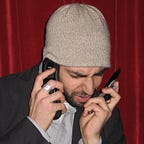School safety… during a pandemic. Part V.
A six-part dialogue between an architect + an educator. With a soundtrack. One year later.
In the 2019–2020 academic year, Barry Svigals was a fellow with our K12 Lab at the Stanford d.school. The purpose of the fellowship was to utilize design approaches to reimagine school safety. Barry brought decades of experience designing K-12 school buildings to this endeavor, including the design of the new Sandy Hook Elementary School. When COVID-19 forced us to shelter-in-place, Barry and I were in the last week of co-teaching a course called Safe By Design which brought together Stanford students and students from ASCEND Middle School in Oakland. We were in the midst of digging into research on student wellbeing, developing collaborations with several national organizations dedicated to school safety, and designing prototypes to help change conversations about what safety can and should mean for K-12 communities…
To get a full background on the letters below, which Barry and I wrote to each other a year ago this week, check out the first post in this series.
DAY FIVE
Barry,
On the role of culture here and now…
In this article, Atul Gawande identifies the five pillars to success in beating this pandemic:
“The four pillars of our strategy — hygiene, distancing, screening, and masks — will not return us to normal life, but, when signs indicate that the virus is under control, they could get people out of their homes and moving again. As I think about how my workplace’s regimen could be transferred to life outside the hospital, however, I have come to realize that there is a fifth element to success: culture. It’s one thing to know what we should be doing; it’s another to do it, rigorously and thoroughly.”
Culture. The fifth element without which the other four crumble.
What is the role of cultural creatives in this moment? Perhaps the same as in every moment. As Eve Ewing answers: to “bring us joy and entertainment… offer a reprieve from the trials of life or a way to understand them,” but also to “create pathways for subversion, for political understanding and solidarity among coalition builders… [to] teach us that lives other than our own have value.” As Eve points out in the New York Times op-ed she wrote shortly after the last presidential election, authoritarians attack the arts because they recognize the immense power that artists hold to “challenge structures of power in ways that would otherwise be dangerous or impossible.” Cultural creatives can help us build collective will to take the lesser known, scarier path–directly into the bright light of the sun.
sam,
OK, I definitely subscribe to that: “Cultural Creatives” helping build collective will. And although I like the sound of taking a path into the sun, what is it illuminating? Our collective humanity? Truth? ”Culture” is such a messy and unruly idea. We see there are cultures within cultures. When there are armed militia surrounding businesses defying the mandates to remain closed, where is our collective will?
So I would return to a theme running through this conversation: what can we offer that might be of help in these messy and unruly times? If we are among the cultural creatives, what do we need to bring into the bright light of the sun? Isn’t that where we began? You’ve reaffirmed our purpose, now what?
Right now, as I look out towards San Francisco, I can barely see the next ridge on the way down into Mill Valley, the fog enveloping, obscuring what I know to be out there. At this moment, I can’t see very far. Closer in, however, I can see the angling rain; closer still, it drips from the gutter’s edge above the window, glistening drops streaking down.
The sun is up there somewhere, its light diffused through the fog and clouds above, strong enough to give a soft brightness in spite of the intervening elements.
Our connection to one another, our collective will is there somewhere. I can believe it because there is a brightness here and there despite the scattered disturbances that at times make us forget its presence. I (we) need to be reminded of its existence when its bright light is obscured. Perhaps that is the mission of the cultural creatives at this present moment. Through the fog that separates us, the fears that confuse us, we reaffirm the power of the sun and we let it illuminate us first of all. Then we can begin to offer what we have in the amplified strength of that reflected light. We hold up examples that we applaud. We point to those forces that rip apart the cultural fabric of our collective humanity: inequality and pervasive prejudices. We reveal unintended effects that contribute to social injustices. Most importantly we join and encourage others to join in the responsibility of revelation.
Actually, the light through the fog, in its delicate touch on things closest to me, reveals more detail and nuance than when the sun is direct and strong. So much in that brightness is lost in the shadows. So perhaps, is there a clarity possible in this time, seeing what’s closest, what’s real, and celebrating it?
“What’s closest, what’s real,” now a year later?
Perhaps the specifics of any moment, while compelling, are not as important as our effort to stay with those questions.
Where do I find a clarity?
Perhaps the quality of our participation, our sensitivity and sincerity, is what will help us appreciate what’s needed for this time, this moment. Then, our actions in the world, our ability to respond with empathy and compassion, might be illuminated in that light.
So how might we be more open to the present need?
Please share your thoughts.
For more questions about school safety — and a place to pose your own — visit ReimagineSchoolSafety.org
Join us again on 5/4 for the final installment of letters and tunes.
